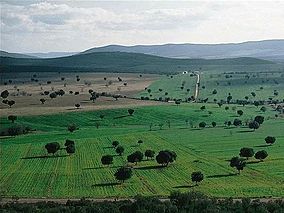Cabañeros National Park
| Cabañeros National Park | |
|---|---|
|
IUCN category II (national park)
|
|

A dehesa, traditional pastoral management in the park
|
|
|
Location in Spain
|
|
| Location | Navas de Estena, Retuerta del Bullaque, Alcoba de los Montes, Horcajo de los Montes, Hontanar. |
| Nearest city | Toledo |
| Coordinates | 39°23′47″N 4°29′14″W / 39.39639°N 4.48722°WCoordinates: 39°23′47″N 4°29′14″W / 39.39639°N 4.48722°W |
| Area | 409 km² |
| Established | 20 November 1995 |
| Visitors | 75000 approx. (in 2007) |
| Governing body | Parques, (Spanish Ministry of Environment) |
Cabañeros National Park (in Spanish: Parque Nacional de Cabañeros) is a national park in the Montes de Toledo, Spain. It falls within two provinces, the northwest of Ciudad Real and the southwest of Toledo.
The Park was designated in 1995 and has an area of 390 square kilometres (150 sq mi). It lies between the Estena and Bullaque rivers, extending into the Chorito and Miraflores mountain ranges.
It is the best and largest surviving area of Iberian Mediterranean forest, with an enormous variety of plant species. It also includes sites of geological interest (Paleozoic sites known as Cámbrico y Ordovícico del Parque Nacional de Cabañeros).
As a curiosity, their exact antipodes coincide with Tongariro National Park, in New Zealand.Tongariro National Park.
The fauna of the park is notable, both for its variety (276 species of vertebrates) and for the high percentage of endangered species. Mammals include the otter in the Estena river and four species of ungulates: wild boar, red deer, roe deer and (in the most forested areas) fallow deer.
The park is potentially a habitat for the Iberian lynx, a critically endangered feline. However, lynx have been sighted only intermittently in the area in recent years, perhaps because of a shortage of rabbits, the main prey species. The Toledo Mountains have been used as a site for the reintroduction of the lynx as part of a LIFE project.
The Park is a Special Protection Area for birdlife, and provides a home for the following notable species:
...
Wikipedia

